Table of Contents
Wave – Vou Te Contar Jobim sheet music (guitar)

TOM JOBIM
Brazilian songwriter and vocalist Antonio Carlos Jobim (1927–1994) was one of the creators of the subtle, whispery, jazz-influenced popular song style known as bossa nova. He has been widely acclaimed as one of Brazil’s greatest and most innovative musicians of the twentieth century.
Jobim’s place in the annals of popular music was secured by a single hit song, “The Girl from Ipanema” (1964), which he co-wrote with lyricist Vinícius de Moraes. His creative contributions to jazz, however, went much deeper; many of his songs became jazz standards, and, in the words of Richard S. Ginell of the All Music Guide , “Every other set” performed in jazz clubs “seems to contain at least one bossa nova.”
Jobim was sometimes called the George Gershwin of Brazil, not so much because of any musical or lyric similarity—Jobim’s songs tended to have oblique, often poetic lyrics quite unlike the clever romantic rhymes of George Gershwin’s brother Ira—but because his music became the bedrock for the work of jazz musicians for decades after its creation.
Studied with German Music Teacher
Antonio Carlos Brasileiro de Almeida Jobim, often known by the nickname Tom, was born in Rio de Janeiro on January 25, 1927. He grew up in the seaside southern Rio suburb of Ipanema, later the setting for his most famous song, and many of his compositions reflected Brazil’s lush natural world in one way or another. Both of Jobim’s parents were educators, and his father, Jorge Jobim, was also active as a diplomat.
But Jobim took after an uncle who played classical guitar, and he soon showed unusual talent of his own. Jobim’s mother, Nilza, rented a piano for the family home, and when Jobim was 14 he began piano lessons with Hans Joachim Koellrutter, a local music scholar of German background who favored the latest experimental trends in European classical music.
Please, subscribe to our Library.
If you are already a subscriber, please, check our NEW SCORES’ page every month for new sheet music. THANK YOU!
Jobim would later point to the influence exerted by French Impressionist composers Claude Debussy and Maurice Ravel on his own music, but a new set of influences was on its way to Brazil in the form of American jazz. Jobim enrolled in architecture school, lasted less than a year, and worked as an assistant to a local architect in the early 1940s.
His real energies were directed toward music, as he gained experience playing piano in small nightclubs known as inferninhos , or little infernos. Visits to Rio by the Duke Ellington Orchestra and other American jazz bands shaped Jobim’s own attempts at composition (which he buried in a drawer at first) and inspired him to settle on a musical career. In 1949 he married his first wife, Thereza Hermanny; they raised a son, Paulo, and a daughter, Elisabeth.

With his well-rounded musical education, by the early 1950s Jobim was able to graduate from Rio’s bars to staff arranging positions with the Continental and Odeon record labels. At this point Jobim was working in the genre of samba, Brazil’s national pop song style, and he sometimes performed his own samba compositions.
His real breakthrough came about in 1956, as the result of a chance meeting two years earlier with Brazilian playwright Vinícius de Moraes. Moraes was working on a play called Orfeu da Conceicção , which was later filmed as Orfeu Negro (Black Orpheus). The play and film transferred the classic Greek myth of Orpheus and Eurydice to modern-day Rio de Janeiro, and Moraes suggested that Jobim write the music for it.
The film Orfeu Negro became an international success, and Jobim’s score, featuring guitarist Luiz Bonfá, kicked off a new musical craze that quickly spread beyond Brazil. It was based in samba rhythms, but it featured subtle harmonic shadings drawn from jazz.
The new style was given the name bossa nova, meaning “new wave,” and the 1958 single “Chega de Saudade” (No More Blues), with music by Jobim, words by Moraes, and guitar by future Brazilian pop star João Gilberto, was the style’s first major hit. Both “Chega de Saudade” and the flip side of the original single, Jobim’s composition “Desafinado” (Out of Tune), have remained jazz standards.
Performed in New York
Jobim’s star rose quickly in Brazil after the release of “Chega de Saudade.” He continued to record with Gilberto, began hosting a weekly television show called O Bom Tom , and wrote music in which he drew on his classical background for the soundtrack to a film called Por Toda a Minha Vida and (with Moraes) Brasîlia, Sinfonia da Alvorada , a four-movement orchestral work with text.
By 1962 American jazz musicians had begun to immerse themselves in bossa nova. Jobim sang his “Samba de uma nota só” (One-Note Samba) on an album by Gilberto and jazz flutist Herbie Mann. The bossa nova phenomenon reached the United States as saxophonist Stan Getz and guitarist Charlie Byrd recorded their successful Jazz Samba album, and in November of 1962 Jobim and other Brazilian musicians performed a major bossa nova concert at New York’s Carnegie Hall. The show was the idea of a Brazilian diplomat who wanted to promote the country’s musical accomplishments abroad.
Best Sheet Music download from our Library.
The concert initially seemed to be a flop. The Brazilian players were thrown off their stride by New York’s miserable late fall weather, and critics panned the show. Jobim and his compatriots also took criticism from Brazilian observers who felt they were diluting Brazilian music by singing songs in English—Jobim, who spoke several languages, sometimes translated his own songs from Portuguese into English, while others were translated by jazz writer Gene Lees. Nevertheless, the Carnegie Hall concert succeeded in exposing Jobim to American musicians and music industry figures.

Jobim recognized the importance of American exposure in broadening the reach of his music, and he quipped that if he had remained in Brazil, he would still just be drinking beer in Rio’s corner bars. In 1963 he made his U.S. recording debut on the Verve label with The Composer of Desafinado Plays.
Jobim followed up that release with several more albums in a smooth jazz vein. He collaborated with one of his most influential American admirers on a successful 1966 release, Francis Albert Sinatra & Antonio Carlos Jobim , which was seldom if ever out of print during the next four decades. Jobim sang, played piano, and occasionally strummed a guitar on these recordings, often backed by a small orchestra.
In 1962 Jobim composed a song that was soon to become a worldwide phenomenon, and in the process he added a phrase to the international lexicon. “The Girl from Ipanema” (in Portuguese, “Garota de Ipanema”) was written as Jobim and Moraes were sitting at a table in a bar in Jobim’s hometown of Ipanema and became infatuated with a passer-by, the “tall and tan and young and lovely” woman described in the song. With a vocal by Gilberto’s wife, Astrud, and a verse of English lyrics, the song became a number-two hit in the United States in 1964, eclipsed only by the Beatles’ “A Hard Day’s Night.”
Jobim prospered, although he was never canny about the music publishing deals he signed, and he often failed to receive a proper share of the money his songs earned.
Jobim’s total output of albums was not large (he recorded ten solo albums, plus nine more with collaborators), but his music remained consistently successful through much of the 1960s.
Nothing else became a hit on the scale of “The Girl from Ipanema,” but such songs as “Wave,” “Insensatez” (How Insensitive), and “Meditation,” with vocals by Jobim himself, Astrud Gilberto, or other singers, became part of the record collections of many sophisticates, and were internalized by jazz musicians as quickly as they appeared. Jobim maintained a strong following in Brazil, thanks to duets recorded with female vocalist Elis Regina, and his 1968 album A Certain Mr. Jobim reached the top 15 on Billboard magazine’s jazz sales chart in the United States.
Branched Out Beyond Bossa Nova
Jobim’s popularity dipped in the 1970s as bossa nova finally ran out of steam commercially, but he never really slowed down creatively. One of his most widely covered songs of the decade was 1972’s “Aguas de Março,” which Jobim himself translated into English (with added lyrics) as “Waters of March”; the English version almost completely avoided words with roots in Romance languages (such as Portuguese) in favor of those of Germanic origin. The lyrics consisted of a seemingly disconnected series of images that suggested the impermanence of life.
The influential jazz critic Leonard Feather, according to Mark Holston of Americas , placed “Waters of March” “among the top ten songs of all time.” Jobim recorded with Brazilian-born arranger Eumir Deodato on his Stone Flower album of 1970, and he also often worked with German-born arranger Claus Ogerman. Jobim’s 1975 album Urubu (meaning “The Vulture”) reflected his personal fascination with that bird of prey.
In 1976 Jobim met 19-year-old photographer Ana Beatriz Lontra; the pair had a son, João Francisco, in 1979, married in 1986, and had a daughter, Maria Luiza Helena, in 1987. In the late 1970s Jobim was active mostly in film soundtracks, but in 1984 he assembled his Nova Banda or New Band, with his son Paulo on guitar, and began touring once again.
His concerts in the United States in the mid-1980s were in venues with the highest profiles: Carnegie Hall and Avery Fisher Hall in New York, and Constitution Hall in Washington. His 1987 release Passarim was as well received in the jazz community as any of his 1960s releases had been, and selections from it appeared on several posthumous collections of his work.
Critics by this time recognized Jobim as a living legend, and he received various awards of national and international scope in the last years of his life. These included the Diploma of Honor, the highest arts award given by the Organization of American States, which he received in 1988, and induction into the Songwriters’ Hall of Fame in 1991.
Jobim never rested on his laurels, and he entered the mid-1990s with a full plate of creative projects. He worked with classical conductor Ettore Stratta in preparing recordings of some of his more classical-oriented works, and he planned to record an album with opera star Kathleen Battle. In 1994 Jobim released a new album, Antonio Brasileiro , and rejoined Frank Sinatra for a track on Sinatra’s Duets II release.
With these career capstones in the works, it came as a shock for Jobim’s admirers in both the United States and Brazil when Jobim died suddenly of heart failure at New York’s Mount Sinai Hospital on December 8, 1994, shortly after entering the facility for treatment of cardiac disease. Jobim’s body was returned to Brazil, where a funeral parade held in his honor in Rio de Janeiro lasted for four hours, and he was buried in a tomb near that of Vinícius de Moraes, who had died in 1980.
The pair had created two of the icons of twentieth-century culture, Black Orpheus and “The Girl from Ipanema,” and the music that came from Jobim’s pen lent the music of much of the century’s second half a distinct Brazilian tinge.
Browse in the Library:
| Artist or Composer / Score name | Cover | List of Contents |
|---|---|---|
| Bach J.S. Cello Suite No. 6 arr. piano solo by Joachim Raff |
 |
|
| Bach J.S. Cello Suite No.1 arr. for piano solo |
 |
|
| Bach J.S. D’Albert Siciliano from BWV 1031 Piano solo transcription |
 |
|
| Bach J.S. Das Musikalisches Opfer BWV 1070 |
 |
|
| Bach J.S. Fifield Transcription Cantata BWV 147 Jesu, Joy of Man’s Desiring piano solo |
 |
|
| Bach J.S. Harpsichord Concerto A-major arr. 2 pianos | ||
| Bach J.S. J.S.- Das Wohltemperierte Klavier I (Urtext) |
 |
|
| Bach J.S. Marcello – BWV 974 Concert no. 3 | ||
| Bach J.S. My First Book of Bach favorite pieces in easy piano arrangements by D. Dutkanicz |
 |
Bach J.S. My First Book of Bach favorite pieces in easy piano arrangements by D. Dutkanicz |
| Bach J.S. Parodi Siciliano from BWV 1031 Piano solo transcription |
 |
|
| Bach J.S. Prelude XXIV | ||
| Bach J.S. Ricercar 6 BWV 1079 from “The Musical Offering | ||
| Bach J.S. Sarabande for cello | ||
| Bach J.S. Ten Choral Preludes KiV B 27 | ||
| BACH J.S. The Art Of Fugue Bach Fugues For Keyboard, 1715 1750 |
 |
|
| BACH J.S. The little music book of Anna Magdalena (20 easy pieces) |
 |
|
| Bach J.S. Toccata & Fugue Dminor for Piano |
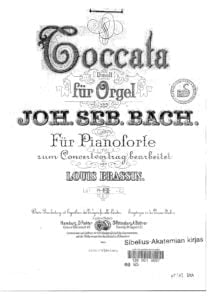 |
|
| Bach J.S. Two Transcriptions Of St. Matthew Passion For Piano Solo |
 |
|
| Bach J.S. Two-Voice Inventions |
 |
|
| Bach J.S.-Busoni BVB36 Prelude Fugue and Allegro BWV998 | ||
| Bach J.S.-Busoni BWV 933-938 | ||
| Bach J.S.-Busoni Prelude in C minor BWV 999 | ||
| Bach J.S.-BWV 1055 4 hands | ||
| Bach J.S.-Choral-BWV-639-Transcr-Busoni | ||
| Bach J.S.-Lipatti – Two Transcriptions of Bach J.S.’s Cantatas 208 | Bach-Lipatti – Two Transcriptions of Bach’s Cantatas 208 | |
| Bach J.S.-Petri – Cantata 208 “Sheep May Safely Graze” Piano solo arr. | Bach-Petri – Cantata 208 Sheep May Safely Graze | |
| Bach J.S.-Siloti- Andante from Sonata for Solo Violin BWV 1003 | ||
| Bach JS “Sheep May Safely Graze” from Cantata 208 (easy piano) |
 |
|
| Bach Liszt Prelude & Fugue In A Minor, Bwv 543 |
 |
|
| BACH Master Musicians Series by Malcom Boyd (eBook) Biography |
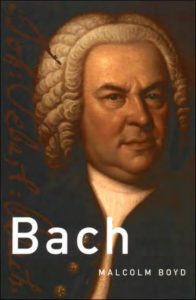 |
|
| Bach Prelude Iv Bwv 849 Wtc I (Musescore File).mscz | ||
| Bach The Goldberg Variations Cambridge Music Handbooks (eBook) |
 |
|
| Bach The Goldberg Variations Cambridge Un. Press (Book) |
 |
|
| Bach The New Bach Reader A Life Of Johann Sebastian Bach In Letters And Documents (Arthur Mendel Hans T. David Christoph Wolff) Book |
 |
|
| Bach Toccata And Fugue In D Minor (Piano Solo) (Musescore File).mscz | ||
| Bach Toccata and Fugue in D Minor BWV 565 (Piano solo arr.) |
 |
|
| Bach Toccata And Fugue In D Minor Bwv 565 (Piano Solo Arr.) (Musescore File).mscz | ||
| Bach Two Part Inventions (No. 1 Bwv 772) (Musescore File).mscz | ||
| Bach-Bauer Die Seele Ruht..Cantata 127 for piano solo | ||
| Bach-Busoni – Chaconne D minor arr. piano solo |
 |
|
| Bach-Busoni Ich Ruf’ Zu Dir Herr Bwv 639 Piano Solo Arr. (Musescore File).mscz | ||
| Bach-Gouin – Harpsichord Concerto in F Minor (Arioso) BWV1056 piano |
 |
|
| Bach-Rummel Ertodt-Uns BWV22 |
 |
|
| Bach-Siloti – Praeludium In B Minor BWV 855a | Bach-Siloti – Praeludium In B Minor Bwv 855a | |
| Bach-Siloti – Praeludium In B Minor Bwv 855a (Musescore File).mscz | ||
| Bach-Siloti Transcription of Bach’s Air from Suite for String Orchestra No.3, BWV 1068 | ||
| Bach-Stradal Trio Sonata No 4 in E minor BWV 528 |
 |
|
| Bach, Johann Sebastian – Complete Lute Music (transcribed for Guitar) |
 |
|
| Bach, J. S. Concert In D Minor Bwv 1043 For Two Violins And Piano Musescore File.mscz | ||
| Bach, J.S. Jesus Bleibet Meine Freude Easy Guitar Arr. Jesu, Joy Of Man’s Desiring Cantata Nr. 147 | Bach, J.S. – – Jesu Bleibet Meine Freude Guitar arr. | |
| Bach, J.S. Jesus Bleibet Meine Freude Guitar Arr. Jesu, Joy Of Man’s Desiring Cantata Nr. 147 | Bach, J.S. Jesus Bleibet Meine Freude Guitar Arr. Jesu, Joy Of Man’s Desiring Cantata Nr. 147 | |
| Bach, J.S. Orchestral Suite No. 1 In C Major Bwv 1066 Passepied (Easy Piano Solo) |
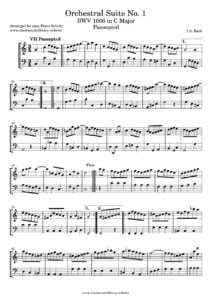 |
|
| Bach, J.S. Arioso For Piano Solo BWV 156 |
 |
|
| Bach, J.S. For Electric Guitar [Guitar SongBook] |
 |
Bach, J.S. For Electric Guitar |
| Bach, J.S. Myra Hess Chorale from Cantata 147 Jesu Joy Of Man’s desiring Hess Myra piano solo Arrangement |
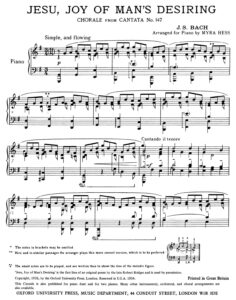 |
|
| Bach, J.S. – Jesus bleibet meine Freude Guitar arr. Jesu, Joy of Man’s Desiring Cantata Nr. 147.mscz | ||
| Bach, J.S. – Jesus_bleibet_meine_Freude_Cantata_Bwv147_10_Choral SATB with Piano by Johann_Sebastian_Bach.mscz | ||
| Bach, J.S. – Toccata and Fugue in D Minor (Piano Solo) |
 |
|
| Bach, J.S. Arioso (Guitar) from Cantata BWV 156 Guitar arr. by Per Orlov Kindgren |
 |
|
| Bach, J.S. Awake, tu us the Voice is calling – Wachet Auf, ruft uns die Stimme Piano solo arr. (Borwick) |
 |
|
| Bach, J.S. Chorale from Cantata 147 Jesu Joy Of Man’s desiring Easy piano solo Arr. |
 |
|
| Bach, J.S. Dinu Lipatti Pastorale in F ( Piano solo transcription) |
 |
|
| Bach, Johann Sebastian (bio book LUX-Lesebogen) (Deutsch-German) Biography |
 |
|
| Bach, JS Partitas Partita 1 |
 |
|
| Bach’s Well-tempered Clavier The 48 Preludes and Fugues (Book ) David Ledbetter |
 |
|
| Bachianas Brasileiras No. 5 (Heitor Villa-Lobos) | ||
| Bachianas Brasileiras No. 5 (Heitor Villa-Lobos) 2 pianos | ||
| Back To The Future |
 |
Back To The Future |
| Backstreet Boys – All I Have To Give | ||
| Backstreet Boys – As Long As You Love Me | ||
| Backstreet Boys – Drowning | ||
| Backstreet Boys – How Did I Fall In Love With You | ||
| Backstreet Boys – I Need You Tonight | ||
| Backstreet Boys – I Want It That Way | ||
| Backstreet Boys – Incomplete | ||
| Backstreet Boys – Quit Playing Games With My Heart | ||
| Backstreet Boys – Show Me The Meaning Of Being Lonely | ||
| Backstreet Boys As Long As You Love Me |
 |
|
| Backstreet Boys Backstreets Back |
 |
|
| Backstreet Boys Black Blue |
 |
|
| Backstreet Boys Drowning |
 |
|
| Backstreet Boys Everybody |
 |
|
| Backstreet Boys I Want It That Way |
 |
|
| Backstreet Boys Shape Of My Heart |
 |
|
| Baden Powell Manha De Carnaval Guitar Tablature Tabs |
 |
|
| Baden Powell – So Por Amor (Guitar arr. sheet music with TABs) | Baden Powell – So Por Amor (Guitar arr. sheet music with TABs) | |
| Baden Powell – Samba Do Aviao (Jobim) Guitar arr |
 |
|
| Baden Powell – Samba Em Preludio Guitar TAB |
 |
|
| Baden Powell – Serenata Do Adeus Guitar TABs |
 |
|
| Baden Powell Complete Brazil On Guitar transcriptions with Tablature |
 |
Baden Powell complete sheet music |
| Baden Powell Contemporary solo guitar (Book In Japanese) |
 |
|
| Baden Powell Prelude In A Minor (guitar) |
 |
|
| Baden Powell Retrato Brasileiro Choro Lento (Guitar) |
 |
|
| Baden Powell Songbook – Volume 1 (Guitar) |
 |
Baden Powell 1 |
| Baden Powell Songbook – Volume 2 (Guitar) |
 |
Baden Powell 2 |
| Baden Powell Songbook Volume 3 (Guitar) |
 |
Baden Powell songbook 3 |
| Badfinger – No Matter What |
 |
|
| Baghdarsaryan, Eduard 24 Preludes For Piano |
 |
|
| Baker’s Biographical Dictionary Of Popular Musicians 1990 Complete Vol 1 A L and Vol 2 M Z |
 |
|
| Balada Para Alessandro (Raul Di Blasio) | ||
| Balázs Havasidom Freedom Piano Solo Sheet Music |
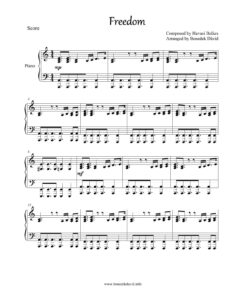 |
|
| Ballad No Name (William Joseph) | ||
| Ballade No. 1 In G Minor (Musescore File).mscz | ||
| Ballads Big Book Of Ballads 2nd Edition Piano Vocal Guitar |
 |
Ballads Big Book Of Ballads 2nd Edition Piano Vocal Guitar |
| Ballads For Classical Guitar |
 |
Ballads For Classical Guitar |
| Ballads Really easy piano (24 great songs) |
 |
Ballads Really easy piano (24 great songs) |
| Ballads The Big Book Of Ballads 3rd Edition Piano Vocal Guitar |
 |
Ballads The Big Book Of Ballads 3rd Edition Piano Vocal Guitar |
| Bambina (Lara Fabian) | ||
| Banana Boat Day-O – Guitarr Arr. With Tabs (Traditional Jamaican Folk Song (Sheet Music) |
 |
|
| Banana Boat Day-O – Guitarr Arr. With Tabs (Traditional Jamaican Folk Song (Sheet Music)) (Musescore File).mscz | ||
| Banana phone (Raffi) | ||
| Bangles – Eternal Flame | ||
| Bar Piano Susi’s – Band 1 – Swing Evergreens and Pop Classics by Susi Weiss |
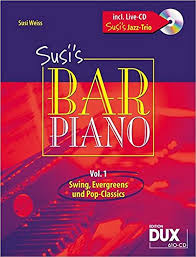 |
Bar Piano Susi’s – Band 1 – Swing Evergreens and Pop Classics by Susi Weiss |
| Bar Piano Susi’s – Band 2 – Swing Evergreens and Pop Classics by Susi Weiss |
 |
Bar Piano Susi’s – Band 2 – Swing Evergreens and Pop Classics by Susi Weiss |
| Bar Piano Susi’s – Band 3 – Swing Evergreens and Pop Classics by Susi Weiss |
 |
Bar Piano Susi’s – Band 3 – Swing Evergreens and Pop Classics by Susi Weiss |
| Bar Piano Susi’s – Band 4 – Swing Evergreens and Pop Classics by Susi Weiss |
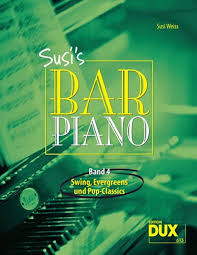 |
Bar Piano Susi’s – Band 4 – Swing Evergreens and Pop Classics by Susi Weiss |
| Bar Piano Susi’s Merry Christmas by Susi Weiss |
 |
Bar Piano Susi’s Merry Christmas by Susi Weiss |
| Bar Piano, Susi’s – Band 5 – Swing, Evergreens and Pop Classics by Susi Weiss |
 |
Bar Piano, Susi’s – Band 5 – Swing, Evergreens and Pop Classics |
| Barbara Livre D’or 18 Chansons Partition Musicale |
 |
Barbara Livre D’or 18 Chansons Partition Musicale |
| Barbara Arens Moonbeams |
 |
